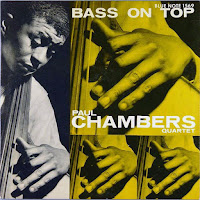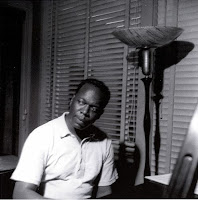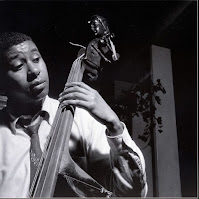Paul Chambers - Bass On Top
Released - September 1957
Recording and Session Information
Van Gelder Studio, Hackensack, NJ, July 14, 1957
Hank Jones, piano; Kenny Burrell, guitar; Paul Chambers, bass; Art Taylor, drums.
tk.3 Dear Old Stockholm
tk.5 Chasin' The Bird
tk.6 Confessin'
tk.8 The Theme
tk.9 Yesterdays
tk.10 You'd Be So Nice To Come Home To
Session Photos
Photos: Francis Wolff
Track Listing
| Side One | ||
| Title | Author | Recording Date |
| Yesterdays | Otto Abels Harbach | 14/07/1957 |
| You'd Be So Nice To Come Home To | Cole Porter | 14/07/1957 |
| Chasin' the Bird | Charlie Parker | 14/07/1957 |
| Side Two | ||
| Dear Old Stockholm | Traditional | 14/07/1957 |
| The Theme | Miles Davis | 14/07/1957 |
| Confession' | Doc Daugherty, Ellis Reynolds, Neiberg | 14/07/1957 |
Credits
| Cover Photo: | FRANCIS WOLFF |
| Cover Design: | HAROLD FEINSTEIN |
| Engineer: | RUDY VAN GELDER |
| Producer: | ALFRED LION |
| Liner Notes: | ROBERT LEVIN |
Liner Notes
UNTIL his tragic death from tuberculosis at the age of twenty-two, Jimmy Blanton held the distinction of being the "Bass on Top." Blanton during his all too brief career with the fabulous Duke Ellington band (1939-1941) realized that the potential of the bass transcends its almost exclusive use as a rhythm section instrument and proceeded to extend the range of the bass by exploiting its then almost virgin qualities as a "horn-like" solo vehicle. The recorded solos he left behind testify to the remarkable results his genius produced and make evident the tremendous influence he has had on every modern jazz bassist who came after him. Oscar Pettiford, Percy Heath, Charlie Mingus, Ray Brown, Wendell Marshall, Milt Hinton, Al McKibbon and George Duyivier were the most outstanding of the Blanton followers until Paul Chambers came on the scene.
Paul, the new "Bass on Top", came to New York in the latter part of 1955 and since then has devoted the majority of his time to working with Miles Davis. Miles, the perfectionist, did well in choosing Paul as his regular bassist. Paul's exciting bowed and pizzicato solos and his solid rhythmic line helped spark Miles' quintet to the lofty heights it achieved in clubs and on records. Paul too has benefited greatly from his association with Miles. No musician with any degree of sensitivity can work night after night behind the "great man" without suits of Paul's exposure to Miles can be heard in his music. He is a complete musician now with a deep and expansive conception that, combined with his always brilliant technical prowess, marks him as the bass player to watch, or rather, the bass player to listen to.
Miles is not the only musician to have acknowledged Paul's exceptional talent. Paul won "New Star" honors in the "Musician's Musicians" poll in Leonard Feather's "Encyclopedia of Jazz Yearbook" by receiving almost twice as many votes as his closest rival. Those artists who cast their ballots for him were Jay Jay Johnson, Billy Taylor, Miles, Oscar Pettiford, Dizzy Gillespie, Quincy Jones, Ernie Wilkins, Randy Weston, Chet Baker. Clifford Brown, Horace Silver, Conte Candoli, Herb Geller. Osie Johnson. George Wallington, Frank Wess, Frank Rosolino and Kai Winding.
Paul's biographical data can be found in the liners to his first two Blue Note LPs ('Whims of Chambers", BLP 1534 and the "Paul Chambers Quintet'. BLP 1564) and he can also be heard on Blue Note with Kenny Burrell, BLP 1523 and BLP 1543; Lee Morgan, BLP 1541 and Hank Mobley, BLP 1540.
Kenny Burrell, who more than makes up for the absence of horns on these sides) is well on his way to becoming the "Guitar on Top." Nat Hentoff in his Down Beat review of Kenny's first Blue Note album (BLP 1523) said, "Burrell is easily one of the very best of the young guitarists in conception, time, soul and sound." And Hentoff is not one to sing praises over a new musician unless he is thoroughly convinced of his abilities. Kenny was born in Detroit on July 31, 1931. An older brother, Bill, played bass and guitar and prompted his first interest in jazz. Kenny worked in local groups that included Thad Jones, Tommy Flanagan, Curtis Fuller, etc. before forming a combo of his own which he maintained until he left Detroit to go with Oscar Peterson in the Spring of 1955. He came to New York soon afterwards and like Paul (who is also from Detroit) has decided to stay.
When Hank Jones (another Michiganite) decided to make the "Apple" his home base he made a countless number of New York soloists very happy. Hank has a style and a way of comping that is similar to Tommy Flanagan. He is a pianist of impeccable taste who plays with an easy lyricism and has an intuitive way of "feeding" a soloist in a "just right' manner. For this he can best be described as a "musician's musician", but his own solos, always built on intelligent lines and always moving, are a delight for the listener as well. Hank was born on July 31, 1918 and is the elder brother of Thad and Elvin who have also made their mark in Blue Note annals. He came to New York in 1944, quite a few years prior to the sudden emergence of immigrators from the mid-west in the schools; "Lips" Page, Andy Kirk, Billy Eckstine, Ella Fitzgerald, John Kirby, Benny Goodman, Coleman Hawkins. Howard McGhee, Kenny Clarke, Don Byrd, Gigi Gryce, etc., and has fit in perfectly with each.
Art Taylor was dubbed "The Art of Drumming" by emcee aptly fitting. "The Art of Drumming" has been learned well by A. T. who is surely one of the most proficient drummers in modern jazz. At this writing a member of the Jazz Lab Quintet, Art, who was born in New York on April 6, 1929, has played with Bud Powell, Coleman Hawkins, Lou Donaldson, Miles Davis, Sonny Rollins and Art Farmer, among many others.
In passing I would like to say that this record provides Chambers with more extended solo space than he, or to my knowledge any other bassist, has received before and many of Paul's solo efforts on this record (which you will find to be highly enjoyable and educational — even if you don't play bass) are, I am sure, destined to become as valuable additions to the "collectors" library as are those of Blanton's.
Side one begins with a mournful but not maudlin Yesterdays. Paul bows his way through three choruses with much feeling and Kenny embellishing in a sensitive, pretty fashion, supplies the discreet accompaniment along with Hank and Art. It is Paul's extremely gifted handling of a bow that, as much as anything else, lifts him above the class of the average bass player. He can be likened to a Koussevitzky in this respect, but certainly no one else in jazz.
You'd Be So Nice To Come Home To bounces along in a neat, finger-snapping tempo. Paul, Kenny, Hank and Paul again, are the soloists.
Charlie Parker's Chasin' The Bird provides solo space for the entire quartet. Burrell opens, stating the theme over Chambers who works his way out from under to move into an excursion of his own. Jones follows in a light, groovy mood that is characteristic of him. Burrell returns and Taylor succeeds him before Kenny and Paul go back to the theme.
The beautiful Dear Old Stockholm (a Swedish folk song added to the jazz repertoire by Miles and recorded by him, along with Yesterdays, on BLP 1501) that opens the second side is, for me, the most provocative rendition in this wonderful set. It is mainly a vehicle for Burrell whose statements sandwich those of Chambers and Jones. Each of the solos are bright and cohesive and stick close to the melody. managing to retain the essentially plaintive air of the tune, while the many "breaks", spotted at intervals during and, as a bridge, between the solos, lend an unusual, ominous quality.
The Theme, used as a "sign-off" item by Miles, is a piece that Paul has no doubt become quite familiar with. His bowed solo is swinging and imaginative and leads into a swift romp by Kenny. Hank comes on next with Art and Paul (still bowed) following him with a set of exchanges before the close.
As an encore, the pretty Confessin' has Paul in solo, save for a brief but pertinent bit by Hank, With the remainder of clamation, "Crazy. Chambers!" at the end of the set is a summation of the brilliance of the entire album.
It is sincerely believed in these quarters that Paul Chambers has earned the "Bass on Top" title and to close with a gang of superlatives might seem in order here. But may I suggest instead that you pick up this side — listen to if and use your own superlatives. They will come quickly and easily.
—ROBERT LEVIN
Photo by FRANCIS WOLFF
Cover Design by HAROLD FEINSTEIN
Recording by RUDY VAN GELDER
RVG CD Reissue Liner Notes
A NEW LOOK AT BASS ON TOP
Paul Chambers's rise to the top of the modern bass heap was indeed rapid, thanks to his inherent skill, originality, and arrival at a moment when recording technology was shifting in bass players' favor. In the year Chambers spent in New York before joining the first Miles Davis quintet, he had already established working relationships with several important modernists including J.J. Johnson, Bennie Green, Cannonball Adderley, Donald Byrd, Bud Powell, and George Wallington. The Davis affiliation began just as the long-playing album expanded to its larger 12-inch format, triggering a boom in independent recording that rode on the inspiring Chambers beat (captured so magnificently so many occasions by Rudy Van Gelder) as surely as that of any bassist. Until the end of the decade, when the innovative Scott LaFaro and Charlie Haden attract notice and genre-crossing virtuosi such as Ron Carter and Richard Davis emerged, Chambers was indeed on top.
One of Chambers's primacy was the number of albums that appeared under his name. Bass on Top was the last of a Blue Note set of three that had been taped in the space of only 10 months, and the fourth to appear since the bassist joined Davis. (Chambers' Music, cut during the Quintet's West Coast tour in early 1956, had preceded the Blue Notes.) Even if we ignore other already taped yet only partially issued or unissued sessions, this is a lot of music for a bassist who, unlike Charles Mingus and Oscar Pettiford, had never worked as a leader or established his writing talents apart from his playing. Yet Chambers had the presence, both as a soloist and as a member of the ensembles formed around him, and the rhythmic spark to serve as a focal point on record sessions. His presence guaranteed exceptional results despite the loose, blowing session formats he frequently employed.
The results are notably more singular here, for both the uncommon amount of feature space that he bass receives and the wonderful chamber music mesh of the ensemble. The Chambers sessions that precede this one have their charms (including, in three instances, the presence of John Coltrane), as do the two that followed on the Vee Jay label, but none carry the group and dynamic unity of this date.
The absence of horns is unique in the Chambers discography, and is a particularly risky move for an album where the featured player is a bassist, especially one who (again contrary to the likes of Pettiford, Carter, Ray Brown, and Percy Heath) did not have a double of cello or piccolo bass or baby bass to fall on for variety. Yet Chambers's facility with the bow did in effect present him with a second distinct musical personality, from the perspective of sound if not ideas and phrasing. The bowed work on "Yesterdays" and "The Theme," plus the bonus blues, are keys to the overall success of the program as well as among Chambers's best arco performances.
Miles Davis's stamp on the program extends beyond the connections Robert Levin cites in his original comments. In addition to "Stockholm" (which Stan Getz had recorded before Davis, but which the trumpeter established in the present arrangement), "Yesterdays" (Davis did it with Lee Konitz on New Jazz before his Blue Note version), and "The Theme," "Chasin' the Bird" goes back to Davis's days with Charlie Parker a decade earlier, and features a two-part theme along the lines of another Parker composition and Davis Quintet staple "Ah-leu-cha," This musical terrain was also well known to drummer Art Taylor, who had replaced Philly Joe Jones in the Davis quintet for much of 1957. Chambers and Taylor were in the middle of the sessions that comprise the Davis/Gil Evans classic Miles Ahead (Miles Davis + 19) when the present music was taped.
The presence of Kenny Burrell and Hank Jones adds a distinctly Michigan flavor to the present quartet, as well as a more lyrical edge that again reinforces Chambers's primary profile in the ensemble. Burrell, who became almost as ubiquitous on sessions of the period as the bassist, was a frequent partner who had appeared the previous September on Whims of Chambers and would continue the association on several more dates at Van Gelder's into the next decade. Hank Jones, from an earlier Detroit-area generation, developed a similarly lengthy if less voluminous studio history with Chambers. Of particular note were three sessions for Savoy during 1955—56 in which the pair had formed a rhythm section completed by the great Kenny Clarke, who had also drummed on a couple of the previous Burrell-Chambers meetings. Factor in the estimable Taylor, whose trio acumen had been displayed alongside Bud Powell and Red Garland with and without Chambers, and this album features not only a bass, but also a complete rhythm section "on top."
— Bob Blumenthal, 2006









No comments:
Post a Comment